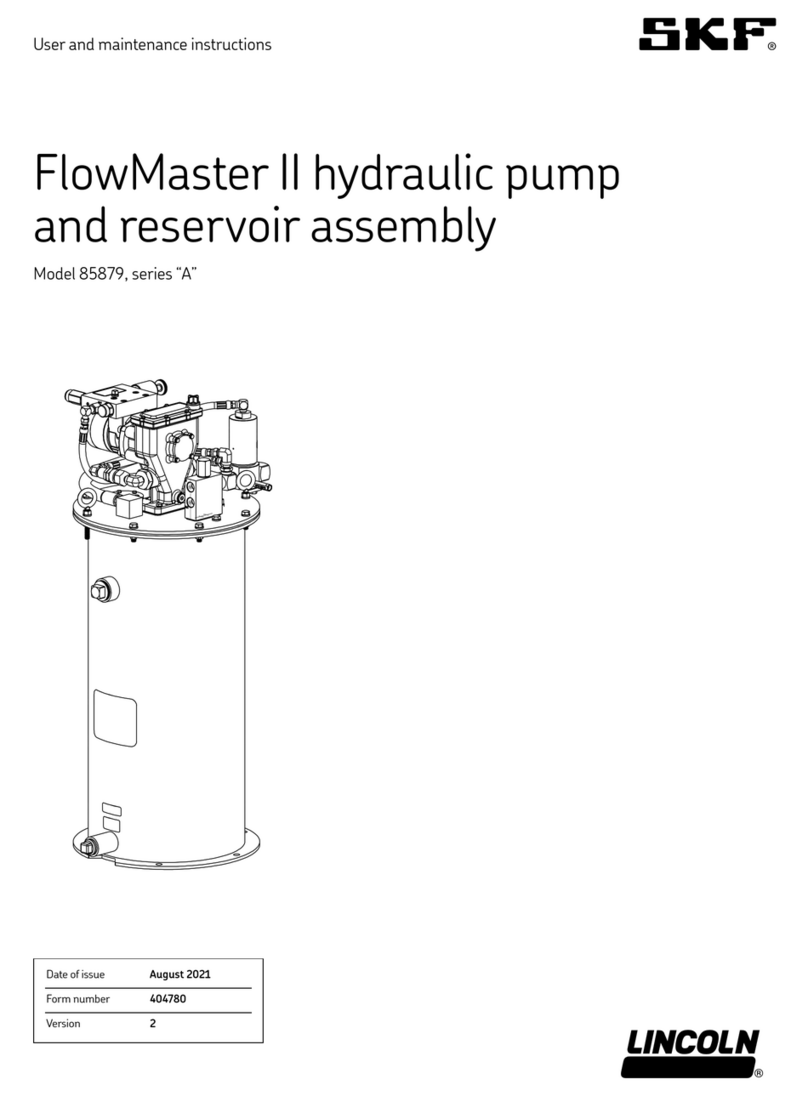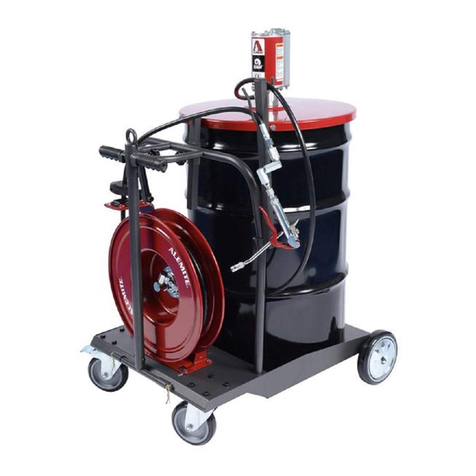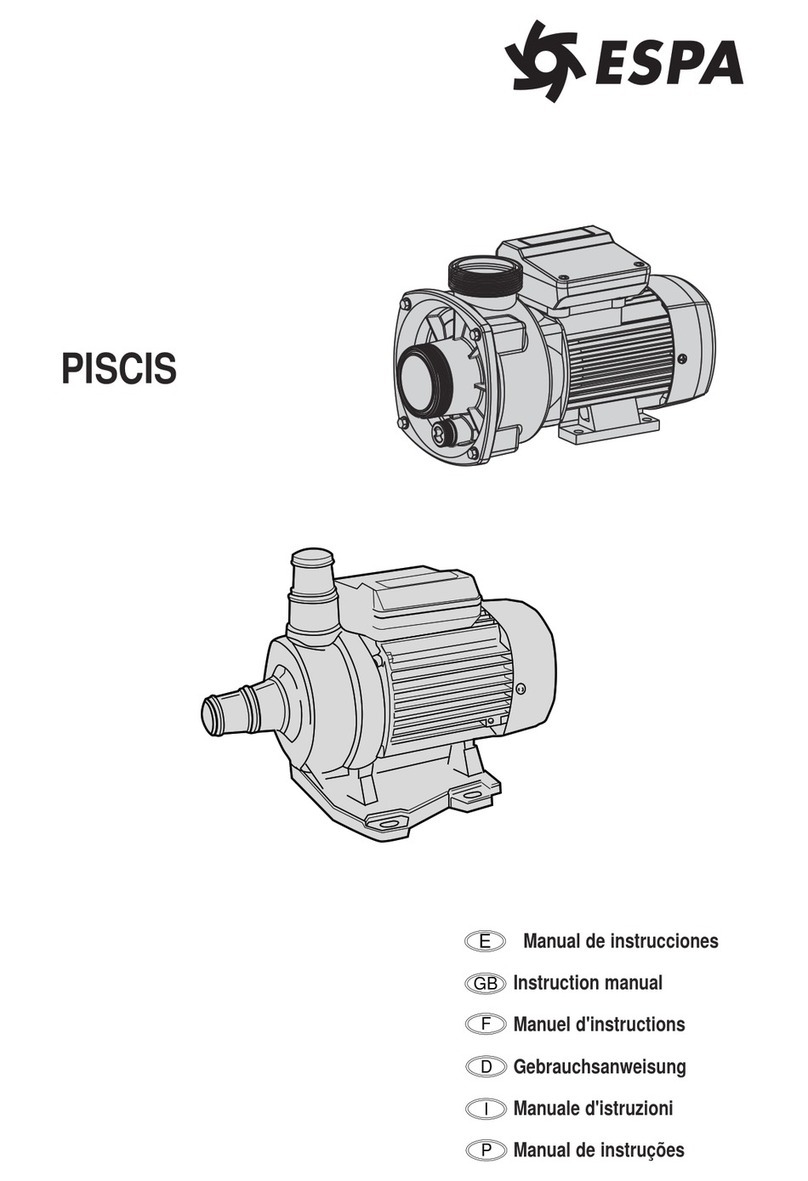Go EBSRAY V Series Manual

Publication # 1301-00
EBSRAY PUMPS
INSTALLATION, OPERATION
AND MAINTENANCE INSTRUCTIONS
V Series
Model V15

2
CONTENTS
SECTION 1 -GENERAL................................................................................................................................. 3
INTRODUCTION................................................................................................................................ 3
1.1 CAUTION.................................................................................................................................... 3
1.2 WARNING................................................................................................................................... 3
1.3 TRANSPORTATION AND PACKING............................................................................................. 3
1.4 INSPECTION ON RECEIPT -SHORTAGES ................................................................................... 3
1.5 HANDLING.................................................................................................................................. 3
SECTION 2 -INSTALLATION ........................................................................................................................ 3
2.1 LOCATION.................................................................................................................................. 3
2.2 FOUNDATIONS ........................................................................................................................... 3
2.3 PUMP PIPING CONNECTIONS .................................................................................................... 3
2.4 STRAINER PROTECTION ............................................................................................................ 3
2.5 ALIGNMENT................................................................................................................................ 4
SECTION 3 -OPERATION............................................................................................................................. 5
3.1 DESCRIPTION............................................................................................................................. 5
3.2 LUBRICATION............................................................................................................................. 5
3.3 START-UP CHECKLIST............................................................................................................... 5
3.4 OPERATIONAL CHECKS ............................................................................................................. 5
SECTION 4 -MAINTENANCE......................................................................................................................... 5
4.1 SPARE PARTS............................................................................................................................ 5
4.2 PREPARATION FOR DISASSEMBLY........................................................................................... 5
4.3 DISASSEMBLY........................................................................................................................... 5
4.4 INSPECTION............................................................................................................................... 6
STANDARD GENERAL CLEARANCES ................................................................................... 7
4.5 REASSEMBLY -PRELIMINARY.................................................................................................... 7
4.6-F REASSEMBLY.......................................................................................................................... 7
PART 1 -Pump .................................................................................................................... 7
PART 2-Bypass Valve........................................................................................................... 8
SECTION 5 -INSTRUCTIONS FOR REVERSING DIRECTION OF ROTATION................................................... 9
SECTION 6 -TROUBLE SHOOTING............................................................................................................. 10
6.1 FAILURE TO DELIVER LIQUID................................................................................................... 10
6.2 LOW OUTPUT........................................................................................................................... 11
6.3 EXCESSIVE POWER CONSUMPTION........................................................................................ 11
6.4 PUMP IS NOISY........................................................................................................................ 11
6.5 LEAKAGE................................................................................................................................. 11
SECTION 7 -PARTS DESIGNATION............................................................................................................ 12
SECTION 8 -TYPE 46 INSPECTION END BEARING ..................................................................................... 14
SECTION 9 -FPC (flow and pressure control) valve................................................................................... 14
EBS-RAY PUMPS PTY. LIMITEDACN 000 061 003
Head Office & Works:
628 Pittwater Road,
BROOKVALE NSW 2100
Tel: (02) 9905 0234
Fax: (02) 9938 3825
www.ebsraypumps.com.au

3
SECTION 1 -GENERAL
INTRODUCTION
This publication is intended to assist those
involved with the installation, operation and
maintenance of EBSRAY Model V15 Rotary Sliding
Vane Pumps. The design, materials and
workmanship incorporated in the manufacture of
EBSRAY pumps make them capable of reliable
operation over a long working life. Correct
installation is essential. Service life is enhanced by
periodic inspection and careful maintenance.
1.1 CAUTION
INSTALLATION AND SERVICING OF THIS
EQUIPMENT SHOULD BE PERFORMED BY
QUALIFIED COMPETENT PERSONNEL IN
ACCORDANCE WITH RELEVANT
STATUTORY REGULATIONS OR CODES, IN
CONJUNCTION WITH THESE INSTRUCTIONS.
When the equipment supplied utilises components
other than those manufactured by EBSRAY e.g.
couplings, speed reducers, electric motors etc,
reference should be made to the original
manufacturer's data before installation or servicing
is commenced. Failure to observe these details
may void warranty.
1.2 WARNING
The pump must be operated within the original
selected design parameters of speed,
temperature, pressure and viscosity. Should any
change be contemplated, please confer with
EBSRAY in order to verify the suitability of such a
change.
1.3 TRANSPORTATION AND PACKING
Standard domestic packing is suitable for
shipment in covered transports. Ports must be
sealed to exclude ingress of solids. When
received on site the pump should be stored in a
dry covered area. If storage is required for other
than a short period prior to installation, special
preservatives and protective wrappings will be
required.
1.4 INSPECTION ON RECEIPT –SHORTAGES
On receipt of equipment, check all items against
the dispatch documents and inspect for damage.
Any damage or shortage incurred during transit
should be noted on the packing note and on both
your own and the carrier's copy of the
consignment note and a claim should be made
immediately on the transport company. Should a
shortage be evident on receipt, notify EBSRAY
immediately giving full details and packing note
number.
1.5 HANDLING
Care should be exercised in moving pumps. A
sling should be placed under or around abare
shaft pump to minimise stress on the shaft or
pump flanges. Baseplate mounted units should be
lifted from under the baseplate below both the
pump and driver ensuring compliance with the
relevant lifting codes.
SECTION 2 -INSTALLATION
2.1 LOCATION
The pumping unit should be placed as close as
practicable to the source of supply remembering
to keep within the NPSH requirement of the pump.
Ensure floor area and headroom allotted are
sufficient for inspection and maintenance. Allow
sufficient space and ventilation for motor cooling
requirements. Be sure to allow for crane or hoist
access if required.
2.2 FOUNDATIONS
Baseplate units should be accurately installed.
When on a concrete foundation, ensure that it has
been poured on a solid footing. NOTE: Position
foundation bolts to match baseplate foundation
plan.
2.3 PUMP PIPING CONNECTIONS
All piping should be supported independently of
and line up accurately with the pump ports.
NOTE: NEVER DRAW PIPING INTO PLACE BY
USE OF FORCE AT THE PORT
CONNECTIONS OF THE PUMP.
II-DSTRAINER PROTECTION
The pump inlet should always be protected by an
efficient inlet strainer of adequate size to
accommodate the liquid viscosity conditions
without causing excessive inlet resistance.
2.4 ALIGNMENT
Alignment of the pump and driver is of extreme
importance for trouble free mechanical operation.
Baseplate mounted units are accurately aligned at

4
the factory. To ensure this has been maintained
during transit alignment MUST BE checked once
before startup and again after the unit has been run
under actual operating conditions. NOTE: The
following procedures are typical only and
reference should be made to data for specific
coupling types.
Figure 4
ANGULAR MISALIGNMENT as shown in Fig.1
should be corrected before eccentricity. Refer
Fig.3, use feeler gauge reading at 90°intervals, the
amount of correction necessary can be easily
determined to bring shaft axes in line.
Misalignment due to ECCENTRICITY as shown in
Fig.2 can now be corrected. Refer Fig.4,
adjustment by use of shims under the driver or
pump will effectively correct error in the vertical
plane. Movement of one of the ends horizontally
will correct error in the horizontal plane. NOTE: If
both coupling halves are of identical diameter,
concentricity may be checked with a straight edge
at 90°intervals.
Figure 1
Figure 2
Figure 3

5
SECTION 3 –OPERATION
3.1 DESCRIPTION
The Ebsray Model V15 is a positive displacement
sliding vane pump, primarily intended for the
transfer of low to medium viscosity liquids. The
pump is of a multi-port design allowing for either
90°or 180°porting options. A blanking plate
covers the unused port. An optional double-ended
drive shaft is available facilitating drive connection
to either end.
The V15 rotor/shaft assembly rotates within a cam
form liner. Lip Seals or Mechanical Seals located
in the bearing housings isolate the bearings from
the pumpage. These sealed grease packed ball
bearings are equipped with eccentric locking
collars thus providing positive axial positioning of
the pump rotor.
Lip seals are fitted to the end covers to minimise
ingress of dust/dirt along the shaft. With the double
ended shaft option, a cap is fitted to the non-drive
end for safety. The pump is protected from
excessive differential pressure rise by an
adjustable bypass valve. System design must
prevent sudden/excessive pressure rise, or shock
due to thermal expansion.
3.2 LUBRICATION
No 'in service' lubrication is required on EBSRAY
Model V15 pumps.
3.3 START-UP CHECKLIST
WARNING: DO NOT RUN PUMP DRY.
_Lubricate as required.
_Check alignment of couplings.
_Ensure freedom of rotation of shaft.
_Check direction of rotation.
WARNING: To prevent damage to pumpset
or system, disengage coupling before
checking direction of rotation.
Do not start pump against closed discharge
valve or with inlet valve throttled.
3.4 OPERATIONAL CHECKS
Inspect pump frequently during the first few hours
of operation for such conditions as excessive
heating of bearings, vibration or unusual noises
etc.
SECTION 4 –MAINTENANCE
PRIOR TO ANY DISASSEMBLY OR SERVICE
VERIFY THAT ALL REQUIREMENTS OF
STATUTORY REGULATIONS OR CODES ARE
MET AND THAT SPECIFIC SITE
REQUIREMENTS ETC ARE SATISFIED.
Some inspections and maintenance tasks can be
performed with the pump 'in line', so long as
complete isolation, depressurising and purging
procedures have been completed. However for
major maintenance, it is recommended that the
pump be removed from the installation.
The following instructions regarding
disassembly/reassembly are relative to major
maintenance.
4.1 SPARE PARTS
1. When ordering spare parts, to ensure a
minimum of delay and correct replacement to
original specification, always quote the pump
Serial Number which is located on the nameplate
of the pump.
2. Advise the Cat #, description, and quantity
required. Ref to Drg No. CMP095
3. Advise complete delivery instructions,
transportation, etc.
4.2 PREPARATION FOR DISASSEMBLY
1. Obtain the appropriate Work Permit if required.
2. Isolate the pump from liquids in inlet and
discharge lines, depressurise and purge out
any toxic, flammable, corrosive or air hardening
liquids.
3. Isolate power supply to motor.
4. Note pump and bypass valve orientation relative
to direction of pump rotation.
5. Disconnect porting connections.
6. Remove pump from installation.
4.3 DISASSEMBLY
CAUTION: TAKE CARE NOT TO DAMAGE
COMPONENTS BY PRISING OR LEVERING IN
ORDER TO RELEASE FITS.
PART I -Bypass Valve
1. Unlock locknut, remove adjusting screw and
locknut from bypass valve cover.
2. Remove bypass valve housing cover and 'O'
ring together with valve, spring and retaining
washer.

6
3. Remove 'O' ring from cover.
4. Remove blanking cover or Valve cartridge.
5. Remove 'O' ring from blanking cover or Valve
cartridge.
PART II -Pump
1. Remove pump coupling half from shaft.
2. Remove shaft cap if fitted.
3. Remove bearing cap from inspection end.
4. Remove lip seal and gasket from bearing cap.
5. Release grubscrew from bearing locking collar,
release locking collar by turning in the direction
opposite to the direction of pump rotation
(providing collar has been previously tightened
in direction of rotation).
NOTE: Bearings are locked to shaft using an
eccentric locking collar which can be locked in
either direction, the manufacturer recommends
locking the collar in the direction of rotation.
6. Remove cap screws from inspection end
bearing housing.
7. Remove cap screws from drive end bearing
housing.
8. Remove drive end bearing housing assembly
including rotor/shaft, vanes etc. by pressure
applied to inspection end of shaft. During this
procedure cradle vanes in rotor by hand. Note
orientation of vanes in relation to pump rotation
then remove vanes and pushrods from rotor.
9. Remove drive end bearing housing cap and
remove lip seal from cap.
10. Release grubscrew from bearing locking
collar then release locking collar by turning
opposite to direction of pump rotation
(providing collar has been previously tightened
in direction of rotation). See note at step 5.
11. Press rotor/shaft assembly from bearing
housing.
12. Remove bearing.
Either: remove lip seals, seal spacer if fitted
and 'O'ring from bearing housing/s, NOTE: If
pump is fitted with press fit seal spacer,
this will have to be tapped out evenly using
a suitable drift.
Or, if fitted with mechanical seal: remove
Stationary seal faces and 'O'rings from
bearing housing/s then loosen grubscrews
and remove rotating seal assemblies from
rotor-on shaft assembly.
13. If required, remove liner from body. Note
orientation.
14. If required, remove port blanking plate and
gasket.
15. If bypass valve seat is damaged or pump
rotation is to be reversed the seat will need to
be removed. Using an appropriate tool,
unscrew the seat locknut, remove the acorn
nut and seat grubscrew, then remove the
seat.
NOTE: For models fitted with balanced
bypass valve, the seat is integral with the
cartridge.
4.4 INSPECTION
1. Inspect rotor/shaft assembly and liner. If
damage or excessive wear is evident, it is
recommended to replace both components.
NOTE: The rotor is a shrink fit on the shaft and is
pinned for positive axial location.
2. Inspect vanes for wear or damage -Refer
Table 1.
3. Inspect vane pushrods for wear, damage and
straightness. Replace as required.
4. Inspect bypass valve assembly and
components for wear or damage. Replace or
refurbish as required.
5. It is recommended that all 'O' rings and lip
seals be replaced at every major overhaul.
6. Inspect both ball bearings for wear. It is
recommended on major overhauls that Ball
Bearings be replaced.
7. Ensure pressure relief ducts in bearing
housings are not obstructed.
8. Ensure weep hole in bearing housing cap is not
obstructed.

7
Figure
5
TABLE 1
STANDARD GENERAL CLEARANCES AND SIZES FOR TEMPERATURES O°°-100°°C
Rotor to liner clearance measured radially at 12 o'clock position. 0.03 -0.08 mm
Total axial clearance -liner minus rotor length measured along axis. 0.08 -0.15 mm
Total vane clearance –liner length minus vane length measured
along axis. 0.10 -0.20 mm
Standard vane height. 21.8 -22.0 mm
Recommended maximum wear on vane height. 2.0 mm
Notes:
1. Dimensions stated are design parameters.
2. High suction lift capability and optimum
performance are achieved when the pump is
maintained within these dimensions, however,
adequate performance may still be achieved
with clearances and dimensions outside those
stated if application parameters allow.
3. If installing new vanes, check their lengths to
comply with clearances stated. NOTE: New
parts from EBSRAY should be the correct size.
As vanes are made from a hygroscopic
material which may swell during storage, some
length adjustment may be required.
4.5 REASSEMBLY -PRELIMINARY
(Refer Drawing No. CMP095)
1. Ensure all parts are clean and free from sharp
edges, burrs etc.
2. Lightly smear all 'O' rings and lip seals with a
compatible good quality lubricant before
assembling.
3. Ensure correct orientation of components:
Bypass valve: For clockwise pump rotation,
adjusting screw position is opposite drive end.
For anti-clockwise pump rotation, adjusting
screw position is at drive end.
Liner: After determining direction of rotation, liner
orientation can be determined. The flow of
pumpage through the pump follows the
direction of movement of the bottom of the
rotor. The liner must be installed with the cast
"S" towards the inlet (suction) side and the cast
"D" towards the discharge side. The thick
section of the liner must be towards the bottom.
Refer Fig 5.
4. Using a suitable tool, (thread in bypass valve is
1/4" BSW) lightly lap bypass valve into seat,
valve should only be lapped until contact is
achieved right around the seat. (Excessive
lapping of the valve will increase the seat width
and prevent the valve from functioning
correctly) Ensure no lapping compound residue
remains on components after lapping.
Location pin
discharge inlet
bleed hole
5. Tap the two location pins into the bearing
housings until they seat in their holes.
6. For pumps fitted with lip seals: Press fit one
or two (depending on configuration) lip seals
into each bearing housing ensuring the sealing
lips face inwards. -The first seal should be
pressed to a depth of 34.5mm from the outer
face of the bearing housing and the second to a
depth of 26.5mm.
For models which utilise a
press fit seal spacer,
spacer must be pressed in
evenly to a depth of 18 mm
from the bearing housing
outer surface (See figure 6)
Fig 6
For pumps fitted with mechanical seals:
Using a new O'ring, and with a suitable
lubricant, fit a stationary seal face to each
bearing housing. Take care to avoid damaging
seal faces.
7. Press fit a lip seal to each bearing housing cap
with the lips facing outwards.
4.6 REASSEMBLY PART 1 -Pump

8
1. Insert liner half way into drive end of body
ensuring correct orientation
(see 4.5)
2. Using a suitable jig, stand rotor/shaft assembly
with drive end up. For pumps fitted with
mechanical seals: Using a new O'ring, fit
rotating seal assembly to shaft. Hold assembly
firmly against rotor while tightening the two
grubscrews.
3. Fit 'O'ring to drive end bearing housing.
4. Place two 0.05mm feeler gauges on top of
rotor. Lubricate shaft and lip seal, then fit drive
end bearing housing to rotor/shaft assembly
taking care to avoid damaging lip seal. (use a
thin shim wrapped around the shaft or a
suitable tapered tube to protect lip seal from
sharp edges of keyway.) If single lip seal is
used place seal spacer over shaft ensuring that
the lugs locate inside the bearing housing slots.
5. Fit bearing to shaft and ensure that it is seated
against the bottom of the bearing housing bore.
6. Fit locking collar to bearing and tighten in
direction of rotation, tighten grubscrew to
secure locking collar.
7. Remove feeler gauges.
8. Fit bearing cap and gasket to bearing housing
and secure with cap screws.
9. Fit two vane pushrods
and four vanes to rotor
as follows: THE
HYDRAULIC RELIEF
SLOTS IN VANE MUST
LEAD THE DIRECTION
OF ROTATION AND
THE VANE PLATES
MUST FACE THE
PUSHRODS. (Refer Fig.
7)
With the shaft horizontal, insert two vanes into
top slots of rotor. Turn rotor 180 degrees whilst
supporting vanes in the rotor. Insert the two
pushrods followed by the other two vanes.
10. Using hands to cradle the vanes in the rotor,
insert the assembly into the protruding end of
the liner. Once the vanes are partially engaged
in the liner bore, rotate bearing housing to
ensure location dowel will engage location
hole in liner and push assembly home.
11. Fasten bearing housing in position using four
cap screws.
12. Fit 'O' ring to inspection end bearing housing.
13. Fit bearing housing to shaft taking care to
protect lip seal from damage. (see 4.) Ensure
correct orientation using locating dowel.
14. Fasten bearing housing in position using four
cap screws.
15. Fit bearing to shaft and ensure that it is seated
against the bottom of the bearing housing
bore.
16. Fit locking collar to bearing and tighten in
direction of rotation, tighten grubscrew to
secure locking collar.
17. Check pump for freedom of rotation.
18. Fit bearing housing cap and gasket, secure
using four cap screws.
19. Fit two plug screws and fibre washers to each
bearing housing as follows:
Fit one long plug screw (M6 x 20) and fibre
washer to each bearing housing in the tapped
hole that is towards the discharge side.
Fit one short plug screw (M6 x 10) and fibre
washer to each bearing housing in the tapped
hole that is towards the inlet side. NOTE:
INCORRECT INSTALLATION OF PLUG
SCREWS MAY RESULT IN PREMATURE
SEAL FAILURE.
20. If double ended shaft is fitted, fit shaft cap to
non-drive end.
PART 2-Bypass Valve
Note: Ensure correct orientation with reference to
pump rotation.
(see section 4.5 paragraph 3.)
1. If valve seat has been removed: Fit valve seat
to pump body, screw seat locknut onto seat
and tighten with a suitable tool. Lock in position
with grubscrew then lock grubscrew with acorn
nut and fibre washer. For models fitted with
balanced seal, Fit cartridge to body with
"O"ring, fasten with four cap screws.
2. Position bypass valve in seat.
3. Fit 'O'ring to bypass valve cover then fit spring,
retaining washer and cover to body. Fasten with
four cap screws.
Figure 7

9
4. Fit valve blanking cover to body with "O"ring,
fasten with four cap screws.
5. Fit adjusting screw with cap and fibre washer to
cover.
Note:The bypass valve will require setting
when the pump is recommissioned.
For increased bypass pressure, rotate
adjusting screw in clockwise direction (i.e.
screw in). For decreased bypass pressure,
rotate adjusting screw anticlockwise (i.e. screw
out).
Always lock adjusting screw cap after any
adjustment is made.
Refit pump coupling half
NOTE: DO NOT USE EXCESSIVE FORCE TO
FIT COUPLING AS THIS MAY DISTURB AXIAL
POSITIONING OF ROTOR/SHAFT.
Re-install pump into system. BEFORE
STARTING PUMP RUN THROUGH STARTUP
CHECKLIST IN SECTION III
SECTION 5 -INSTRUCTIONS FOR REVERSING DIRECTION OF ROTATION
The Ebsray Model V15 pump has its direction of
rotation handed upon assembly (either clockwise
or anti-clockwise when looking at the shaft
from the shaft end which is the drive end). Figure
7 shows the flow path of the liquid and the
orientation of the bypass valve for the different
configurations.
CLOCKWISE ROTATION PUMP:
a. Inlet RH side, Outlet LH side.
b. Bypass valve adjusting screw located on pump
opposite drive end.
ANTI-CLOCKWISE ROTATION PUMP:
a. Inlet LH side, Outlet RH side
b. Bypass valve adjusting screw located on pump
at drive end.
To reverse the direction of rotation four conditions
must be met:
1. The bypass valve must be turned 180°in order
to maintain bypass protection in the new
direction. i.e. adjusting screw must be at the
opposite end to where it was originally relative
to the drive shaft.
2. The hydraulic relief grooves in the vanes must
lead the direction of rotation.
Figure 6

10
3. The cast "S" on the liner must be towards the
inlet port and the cast "D" must be towards the
discharge port.
4. The plug screws and fibre washers in the
bearing housings must be fitted as per
paragraph IV-F 19.
Procedure for Reversing Direction of rotation
of Pump:
NOTE: Before starting this procedure carefully
read SECTION 4 and follow any relevant
preparation instructions.
1. Follow disassembly procedure steps 1, 2, 3, 5,
6&7
2. Remove drive end bearing housing, assembly
including rotor/shaft, vanes etc. by pressure
applied to inspection end of shaft. During this
procedure cradle vanes in rotor by hand.
Note orientation of vanes in relation to pump
rotation.
3. Depending on which configuration is required
either:
a. Rotate body through 180°with liner still in its
original position.
or
b. Remove liner from body and rotate liner through
180°i.e. the thick section of the liner is still at
the bottom and the cast "S" & "D" are opposite
their original positions.
4. Reverse vanes in their respective rotor slots in
order to have the relief grooves leading the new
direction of rotation.
5. Reassemble the removed components taking
care not to damage the 'O'rings or lip seals.
The complete drive end housing assembly
should be fitted first, followed by the inspection
end housing.
Care should be exercised to ensure the location
pins in the covers engage in their holes before
tightening the cover cap screws. The pump
shaft should now rotate freely. Should this not
occur, check for binding of components and/or
foreign matter in pump.
6. Remove D.E. bearing housing cover and lock
bearing locking collar in new direction of
rotation, replace cover.
7. Remove plug screws and fibre washers from
bearing housings, and replace with long screws
toward discharge side and short screws toward
inlet side.
8. If procedure 3 a. has been followed the pump is
now ready for re-commissioning. If only the liner
has been rotated (3.b) the bypass valve must
now be re-oriented to provide protection in the
new direction of flow: For models fitted with
balanced valve, cartridge must be fitted to
opposite end. For models fitted with poppet
valve, valve seat must be removed and
replaced from opposite side:
1. Follow the procedure in SECTION 4.3 PART 1 -
Bypass Valve.
2. Using an appropriate tool, unscrew the bypass
valve seat locknut, remove the acorn nut and
seat grubscrew then remove the seat.
3. Replace the seat from the opposite end of the
body then follow the procedure in SECTION 4.6
PART 2 Bypass Valve.
Should further assistance or guidance be
required please contact your supplier or
EBSRAY PUMPS direct.

11
SECTION 6 -TROUBLE SHOOTING
6.1 FAILURE TO DELIVER LIQUID
1. Incorrect direction of rotation.
2. Inlet filter/strainer blocked or leaking air.
3. Liquid too viscous.
4. No liquid in tank.
5. High static discharge on pump combined with
air in inlet pipe.
6. Valves closed or air leaks in inlet system.
7. Excess internal clearances.
8. Bypass valve jammed in open position.
6.2 LOW OUTPUT
1. Pump speed too low.
2. Cavitation or vaporisation on inlet side of pump.
3. Obstruction in inlet or discharge pipe.
4. Air leakage in inlet pipes or fittings.
5. Bypass valve setting too low -increase
pressure by screwing in adjusting screw. DO
NOT exceed system design pressure or
overload driver.
6. Differential pressure higher than specified duty
point.
7. Viscosity of liquid lower than specified duty
point.
8. Pump parts worn -have pump reconditioned or
replace worn parts.
6.3 EXCESSIVE POWER CONSUMPTION
1. Obstruction in discharge line.
2. Pump operating outside the specified duty point
(i.e. high pressure or viscosity)
3. Rotating parts binding -disassemble pump and
inspect.
4. Misalignment between pump and driver -check
coupling and realign as required.
5. Inherent pipe stresses causing distortion of
pump and casing -rectify and realign before
reassembling.
6. Bearings worn -inspect and replace as
required.
6.4 PUMP IS NOISY
1. Air leakage in inlet piping.
2. Cavitation due to insufficient NPSH available i.e.
inlet conditions extreme -reduce inlet losses.
3. Pump running dry -remove blockages in inlet
line/strainer.
4. Pump and driver misaligned -check coupling
and realign as required.
5. Rotating elements binding or broken -
disassemble and inspect.
6. Bearings worn -inspect and replace as
required.
6.5 LEAKAGE
1. From covers and flanges:
a) Set screws not tight -retighten.
b) Damaged 'O' ring seals or gaskets-replace.
c) Check for thermal expansion of product
when locked between valves either side of
pump. Remove hydraulic lock potential.
2. From lip seal:
a) Lip seals incorrectly installed, worn or
damaged -replace.
b) Misalignment between pump and driver
causing excessive shaft distortion -check
coupling and realign as required.
c) Worn or damaged shaft in seal zone -
replace rotor/shaft.
d) Excess system pressure:
i) check for obstructions in discharge line.
ii) check for thermal expansion of product
when locked between valves either side
of pump. Remove hydraulic lock potential.

12
SECTION 7 -PARTS DESIGNATION
EBSRAY MODEL: V15 Rotary Sliding Vane pumps.
REFER TO DRAWING Nº: CMP024 and Notes below.
Cat# Description Qty Cat# Description Qty
100 Body 1425 Valve Spindle 1
101 Liner 1502 Seal Washer 1 or 2
102 Rotor/Shaftassembly 1500 Mechanical Seal Assembly 1 or 2
109 Location pin-Liner/Bearing housing 2503 Stationary Face–Mechanical Seal 1 or 2
111 Vane 4504 Rotating Face–Mechanical Seal 1 or 2
115 Pushrod 2505 Seal Spring–Mechanical Seal 1 or 2
200 Bearing Housing 1507 Grubscrew –Mechanical Seal 1 or 2
202 Bearing Housing Cap 1508 O’ring –Rotating–Mechanical Seal 1 or 2
203 Gasket -Bearing Housing Cap 1510 O’ring –Stationary –Mechanical
Seal 1 or 2
204 Bearing 1511 Lip Seal-Bearing Housing 1,2,4
300 Bearing Housing 1512 Lip Seal-Bearing Housing Cap 1,2
304 Bearing 1515 'O'ring -Body 2
318 Seal Spacer 1516 'O'ring -Bypass Valve Cover 2
400 Cover -Bypass Valve 1604 Port Blanking plate 1
401 Adjusting Screw-Bypass Valve 1605 Gasket -Port Blanking Plate 1
404 Cap -Bypass Valve Adjusting Screw 1
405 Fibre Washer -Bypass Valve Adjusting Screw
Cap 1
406 Blanking cover -Bypass Valve Housing 1
407 Cartridge-Bypass Valve Housing
409 Bypass Valve 1
410 Seat -Bypass Valve 1
411 Locknut -Bypass Valve Seat 1
412 Grubscrew -Bypass Valve Seat 1
413 Acorn Nut -Bypass Valve Seat Grubscrew 1
414 Fibre Washer -Acorn Nut 1
415 Spring -Bypass Valve 1
416 Spring Cap-Bypass Valve Spring 1
424 Blanking cover -Bypass Valve Housing (FPC) 1
424B O’ring-ValveSpindle
Note: Parts listed above and also shown in Drawing # CMP095 include all parts required for V15 pumps of
various different configurations. To ensure supply of correct replacement parts, and correct quantities,
Please supply pump serial number when ordering.

13

14
SECTION 8 –SLEEVE TYPE INSPECTION END BEARING
The EBSRAY V15 type 46 pump is of identical
construction to the types described in this
brochure with the exception of the inspection end
bearing housing assembly.
The following instructions (together with attached
drawing No:CMP095) detail the procedure for
inspection, refurbishment and reassembly of the
inspection end bearing housing assembly.
NOTE:
BEFORE PROCEEDING, READ ALL
WARNINGS AND TAKE ALL
PRECAUTIONS AS OUTLINED IN THIS
BROCHURE. SERVICING OF THIS
EQUIPMENT SHOULD ONLY BE
CARRIED OUT BY COMPETENT
QUALIFIED PERSONNEL.
INSPECTION END BEARING HOUSING
1. Remove inspection end bearing housing
assembly. (300)
2. Inspect inner face of bearing housing for signs
of scoring or excessive wear. If machining is
required, an equal amount (up to a maximum of
1mm) should be removed (machined) from
both the face which is adjacent to rotor and the
face which is in contact with the body.
3. Measure inspection end shaft diameter and
internal diameter of carbon bush (304), if the
total radial clearance is in excess of 0.1mm the
bush should be replaced as follows:
a) Fracture old bush to facilitate removal,
remove bush completely taking care to
avoid damage to bearing housing bore.
b) Shrink fit a new bush ensuring that the
lubrication grooves in the bush are in
alignment with the cast slots in the bearing
housing. Fit to a depth where the bush sits
slightly proud of the inner surface of the
bearing housing.
c) File the bush carefully until it is flush with
the inner surface of the bearing housing.
d) Using a triangular file, file a groove to a
depth of approximately 1mm, across the
end of the bush to create a channel
between the cast slots in the bearing
housing and the precut grooves in the bore
of the bush.
e) Machine or ream the bore of the bush to
achieve a total radial clearance from the
shaft of between 0.05mm and 0.07mm.
Take care to maintain concentricity with the
original bore and squareness with inner
face of bearing housing.
4. The bearing housing assembly can now be
refitted to the pump with the location pin (109)
ensuring correct positioning.
Assembly procedure outlined in Section 4.5 may
be followed, substituting these instructions when
inspection end bearing housing assembly is
referred to.
SECTION 9 -FPC (flow and pressure control) valve.
The FPC feature is an option on a number of V15 models
and is standard on V15 type 81, type 82. The FPC uses
a spindle to enable mechanical opening of the bypass
valve for reduced flow. Assembly and disassembly of
these pumps is identical to the procedure outlined in this
manual except for fitting of the 'O' ring and valve spindle
to the bypass valve housing blanking cover or valve
cartridge.
DISASSEMBLY : After removing bypass valve housing
blanking cover or cartridge, (4.3, part I Bypass Valve
para’ 4) remove spindle and spindle 'O'ring.
REASSEMBLY: Before fitting bypass valve housing
blanking cover or cartridge,(4.6, part 2 Bypass Valve
para 4.) fit spindle 'O' ring to bypass valve housing
blanking cover or cartridge, lubricate and fit spindle
assembly from inside bypass valve housing blanking
cover or cartridge. If the roll pin is not in the centre of the
spindle, the short end of the spindle points toward the
valve with the long end of the spindle projecting from the
cover.
This manual suits for next models
1
Table of contents
Popular Water Pump manuals by other brands
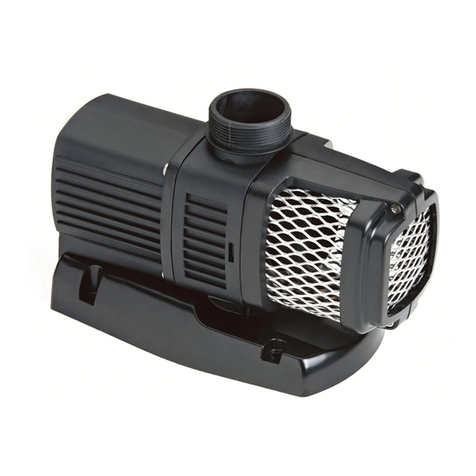
Oase
Oase Optimax 10.000 operating instructions

Trillium
Trillium ROTO-JET VSR 175 Disassembly-assembly manual
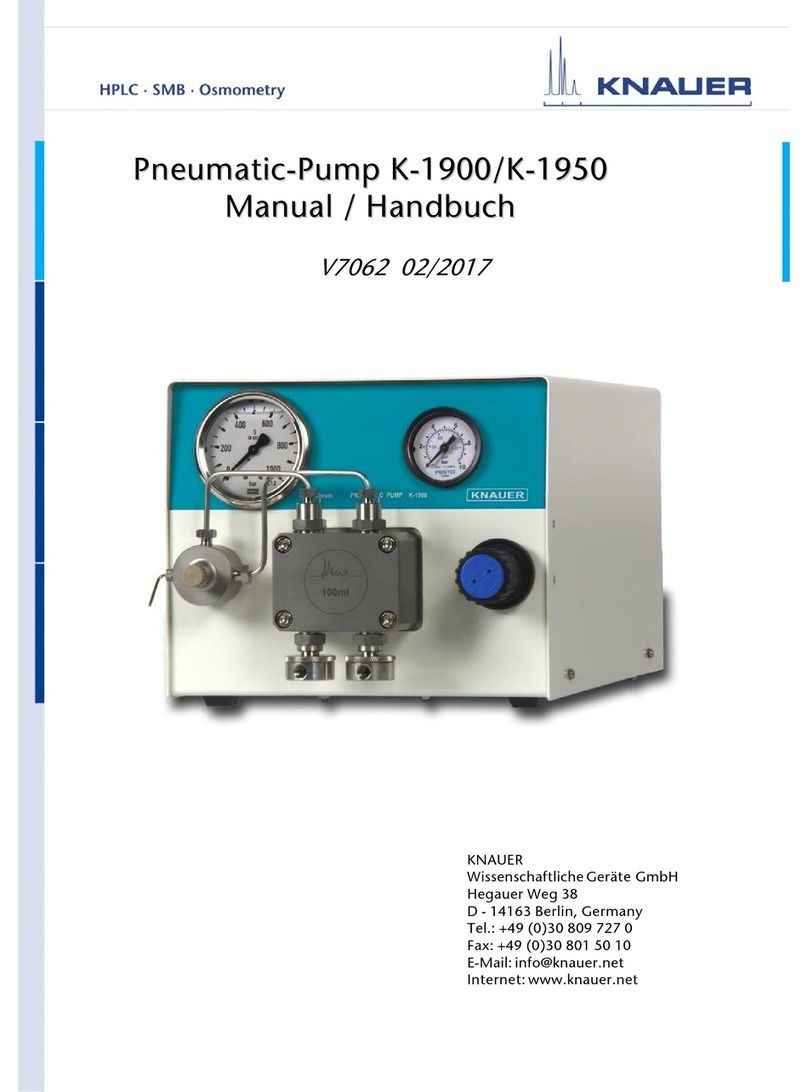
Knauer
Knauer K-1900 manual

BRINKMANN PUMPS
BRINKMANN PUMPS FH Series operating instructions
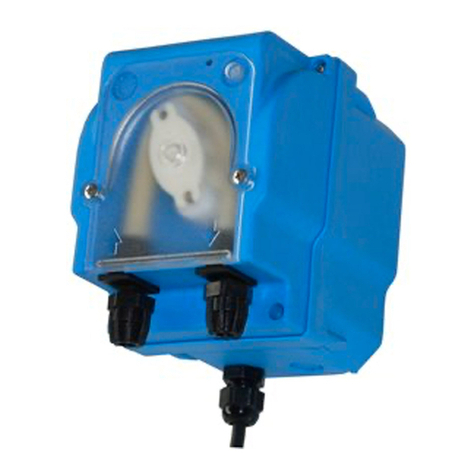
MICRODOS
MICRODOS MP2 SUMMER Installation and maintenance instructions
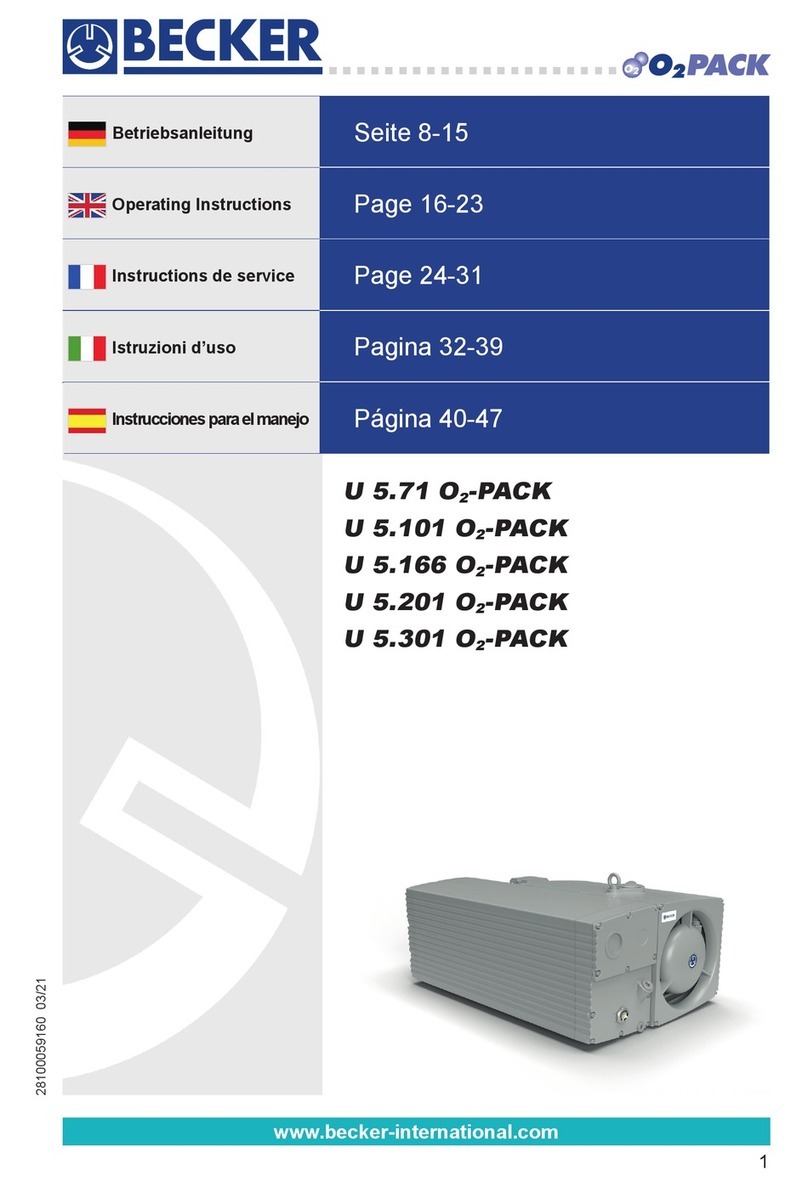
Becker
Becker U 5.101 O2-PACK operating instructions

ITT
ITT Goulds Pumps 3298 Series Installation, operation and maintenance instructions

Crane
Crane Barnes 2SEV Series Installation and operation manual
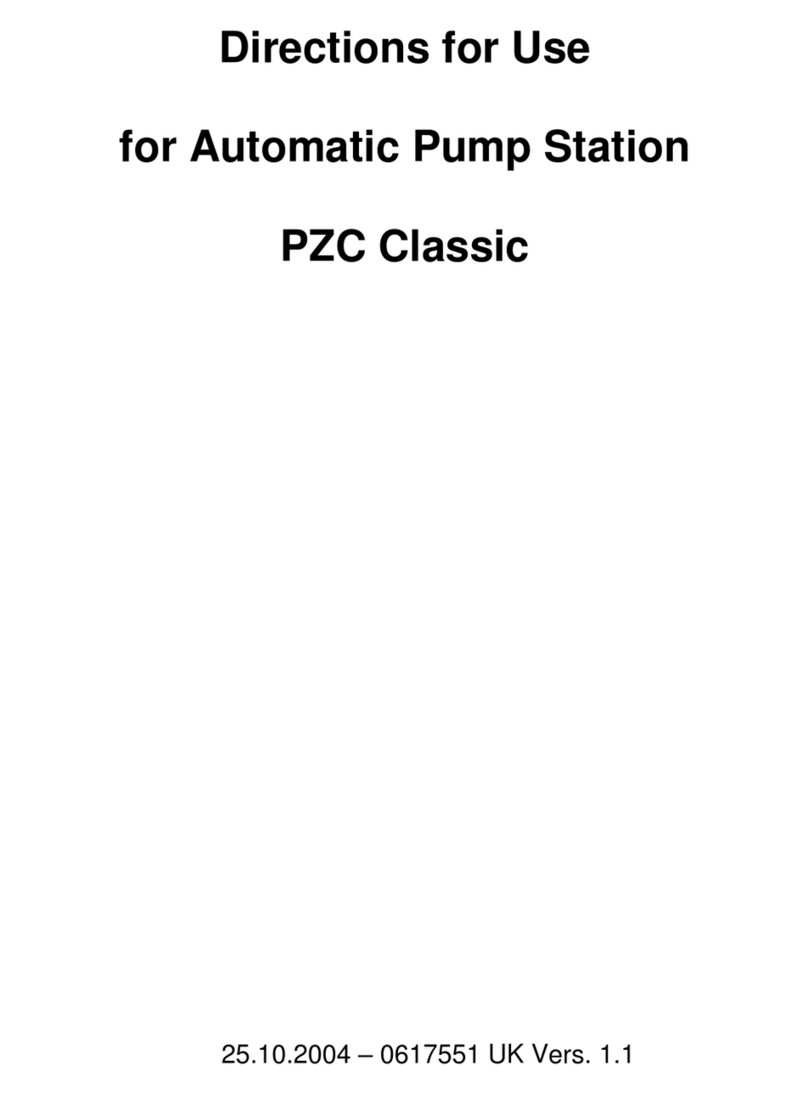
Alto
Alto PZC Classic Directions for use

Sensidyne
Sensidyne GILAIR-3 Operation & service manual

Aquavista
Aquavista 500R Test instructions
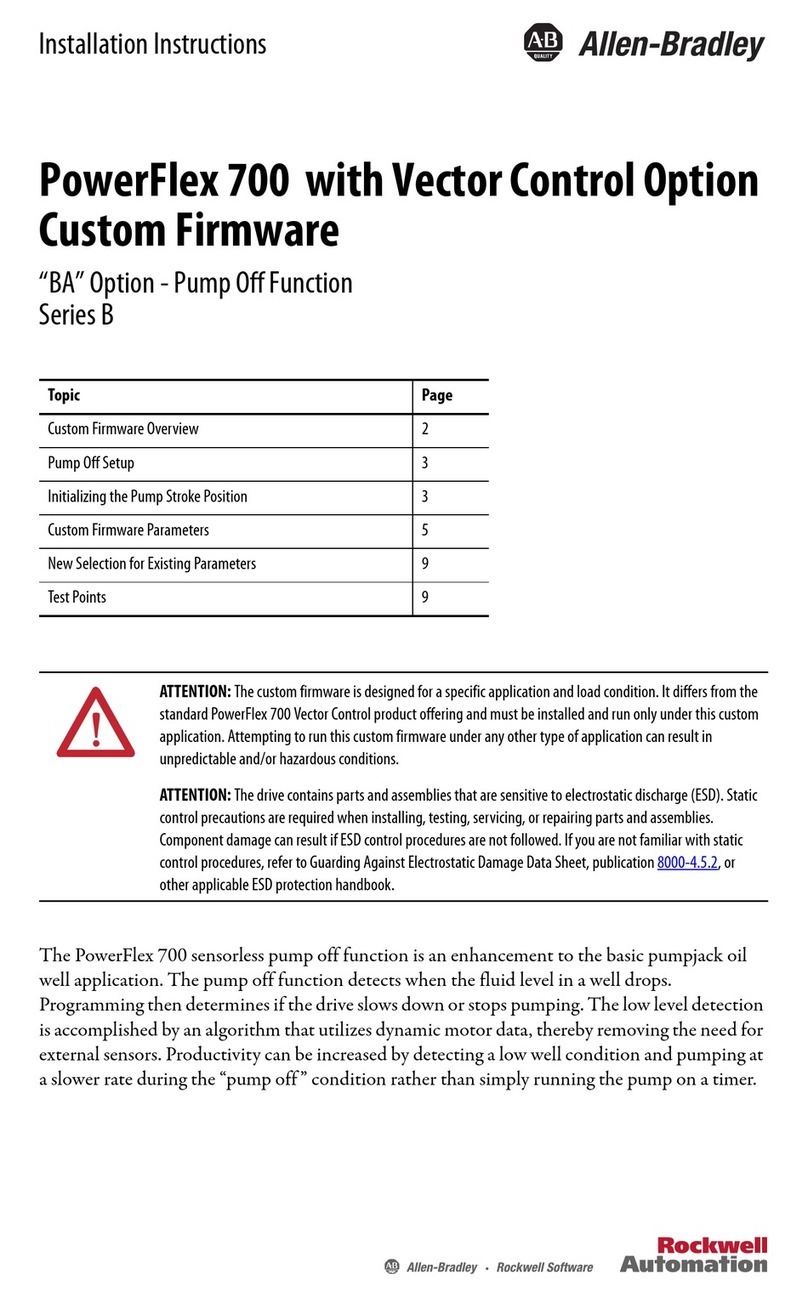
Allen-Bradley
Allen-Bradley powerflex 700 installation instructions
